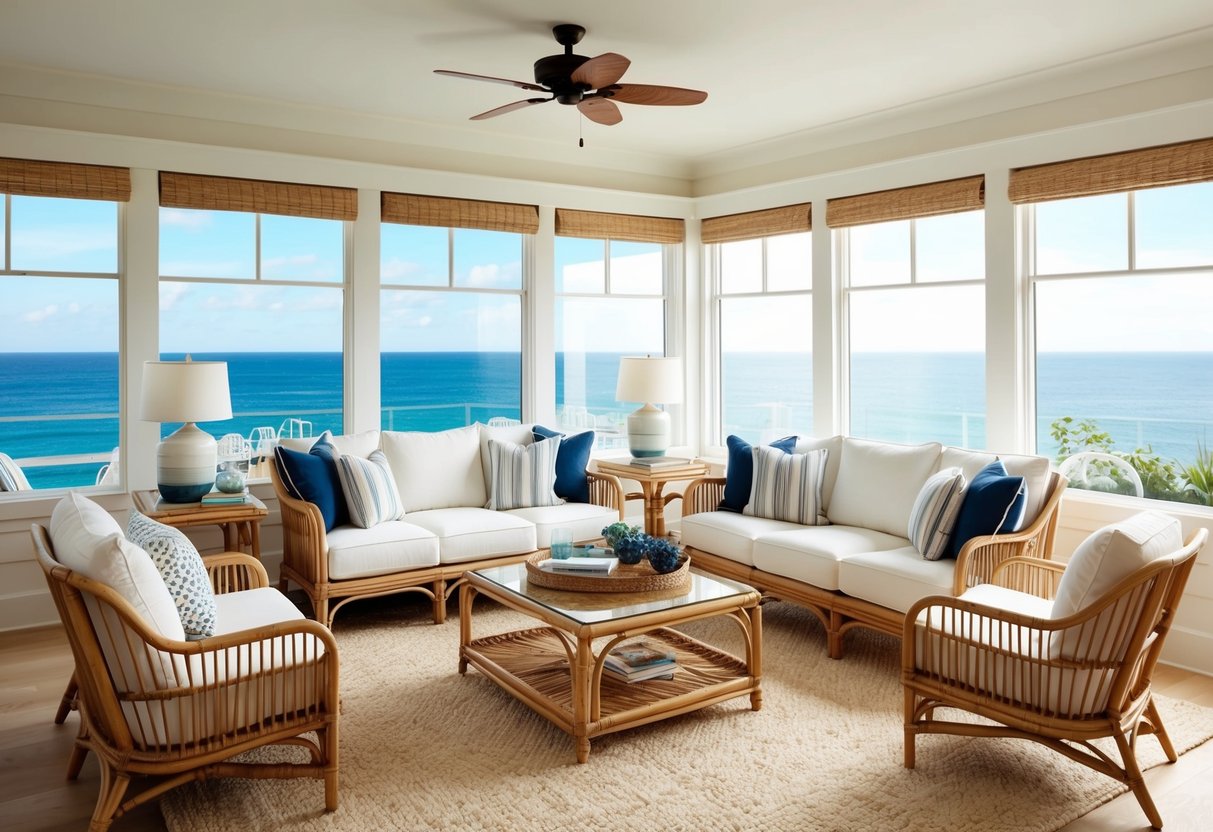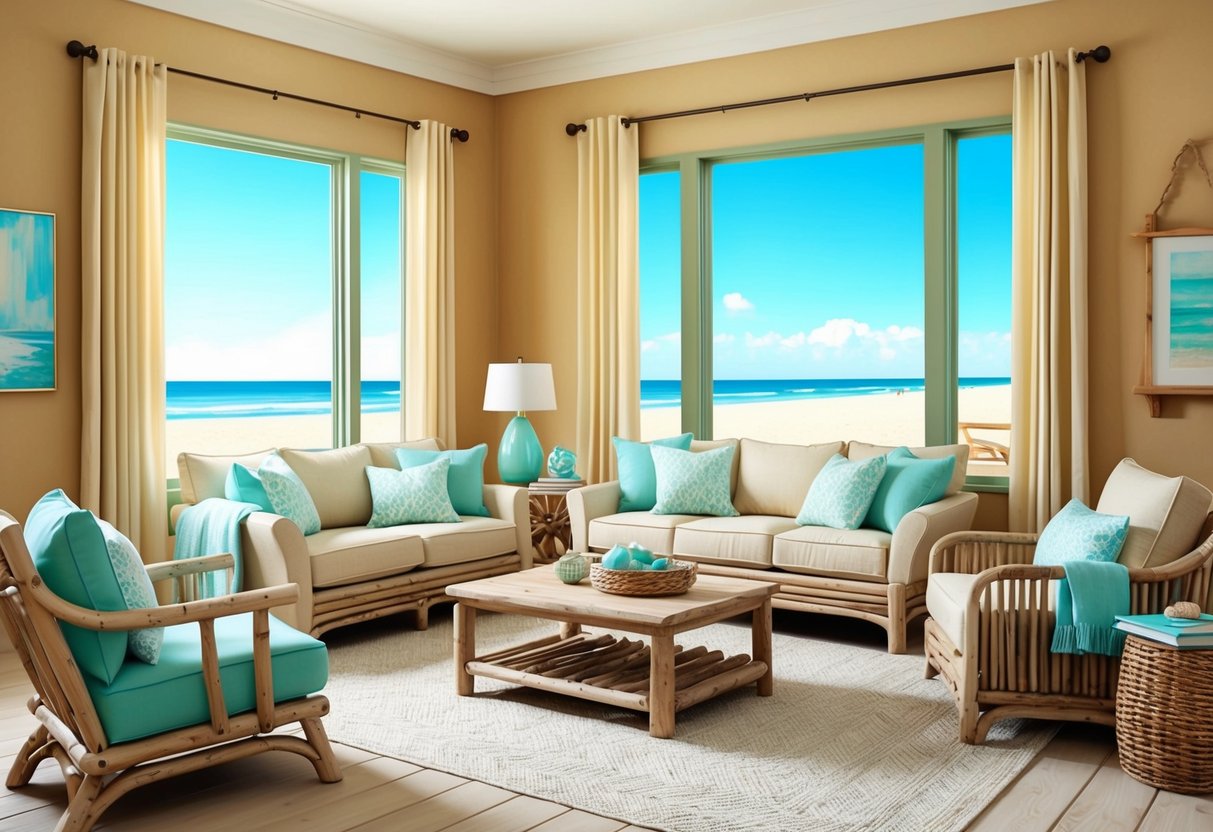
Essential Coastal Color Palette

Coastal interiors rely on a tailored palette inspired by the natural beauty of the beach environment. The blend of sandy neutrals, ocean blues, and nuanced beige tones forms a backdrop that feels fresh, calming, and timeless.
Sandy Neutrals and Soft Whites
A coastal-inspired color palette starts with sandy neutrals and soft whites. These hues emulate sun-bleached beaches, adding warmth and light to interiors without overwhelming the senses.
Popular choices include chalky white, cream, and pale ivory, which reflect natural sunlight and visually expand spaces. Soft whites serve as versatile backdrops, making rooms feel clean and open.
These tones eliminate harsh contrasts and support a serene environment, enhancing the beach-inspired aesthetic. Unifying the walls, trim, or ceilings with a consistent shade of white or off-white can make architectural details and coastal décor stand out.
Pairing whites with sandy hues like light taupe or driftwood beige introduces subtle depth and texture. The result is a harmonious look that mimics coastal sand dunes and creates an inviting atmosphere.
For more examples of these tones, review the Relaxed Coastal Color Collection recommended by color experts.
Introducing Blue and Sea-Inspired Tones
The charm of coastal design is anchored in blue and sea-inspired hues. Varieties of blue, from pale sky to muted navy, reflect the changing moods of the water and sky.
Incorporate shades like aqua, teal, and even washed-out slate for a layered oceanic effect. Adding blue throws, pillows, or accent walls evokes the tranquility of seaside living.
These tones pair seamlessly with sandy neutrals, creating a soothing contrast that enhances the relaxed, beach house vibe. Even a hint of green—think glassy bottled-greens—can reference sea glass and complement the blue spectrum for additional depth.
For people aiming to establish a beach-inspired look, incorporating multiple blue tones prevents the palette from feeling flat. Using color in varying intensities keeps the space visually dynamic while staying true to the theme.
More ideas on color pairings can be found in these tips for modern coastal interior design.
Beige Accents and Neutral Layers
Layering beige and other soft neutrals builds on the foundation of sandy whites and blues. Beige is an anchor for the coastal palette, bringing in natural warmth and an earthy undertone.
It works well on larger surfaces like rugs, upholstery, and window treatments, providing a calming balance to cooler color elements. A mix of textures in neutral shades—linen curtains, jute rugs, and weathered wood—adds tactile interest without deviating from a soft, organic color scheme.
This use of tone-on-tone layering enhances the relaxed, welcoming effect that defines coastal design. Tan, taupe, or warm gray are ideal for blending with both white and blue shades.
By mixing various textures and subtle shifts in neutral color, coastal décor stays engaging but remains uncomplicated. For more detailed guidance on these neutral layers, refer to this overview on coastal interior design style palettes.
Natural Materials and Textures

Choosing natural materials like wood, rattan, and organic fibers is essential for creating a light, relaxed atmosphere in coastal interior design. Carefully selected textures and finishes add both visual and tactile interest, reinforcing a connection to sandy shores and breezy coastal landscapes.
Incorporating Wood and Driftwood
Wood elements evoke the calming feel of seaside cottages and boardwalks. Light-toned woods such as oak, maple, or birch make spaces appear open and airy.
These materials, often used for flooring, ceiling beams, and accent furniture, create a simple foundation that highlights other textures in the room. Driftwood, either as a sculptural piece or incorporated into mirror frames and shelves, brings subtle rustic character.
Its naturally weathered finish reflects the effects of sun and salt spray, adding authenticity to the space. Paired with crisp white walls or pale blue accents, wood and driftwood help ground the design and form a direct link to the beach.
Consider using reclaimed wood tables or driftwood art to introduce organic lines and irregular shapes. This approach avoids overly polished or artificial looks, emphasizing the relaxed, lived-in charm characteristic of modern coastal interior design.
Embracing Rattan, Bamboo, and Woven Jute
Rattan, bamboo, and woven jute add texture and warmth without overwhelming the subtle color palette common in coastal homes. Rattan furniture—such as armchairs, pendant lights, or headboards—offers lightweight strength and an airy woven structure that feels at home by the water.
Bamboo is versatile and sustainable, showing up in blinds, baskets, and accent decor. Both rattan and bamboo support the relaxed, vacation-like vibe by connecting indoor spaces to nature.
Woven jute rugs or poufs provide a tactile experience underfoot and complement hard floors by softening the overall effect. These natural fibers add inviting texture and reinforce the informal, welcoming mood essential for laid-back coastal-inspired interiors.
Sisal and Organic Fibers
Sisal, a durable natural fiber, is ideal for area rugs and runners in high-traffic areas. Its coarse texture brings depth without detracting from clean lines and soft hues.
Unlike synthetic options, sisal keeps the look grounded in eco-friendly materials. Organic fibers such as linen and cotton appear in throw pillows, blankets, and curtains.
They are breathable and comfortable, perfect for creating a fresh, tranquil setting. These soft, tactile textiles layer well and echo the harmonious blend of textures found in nature.